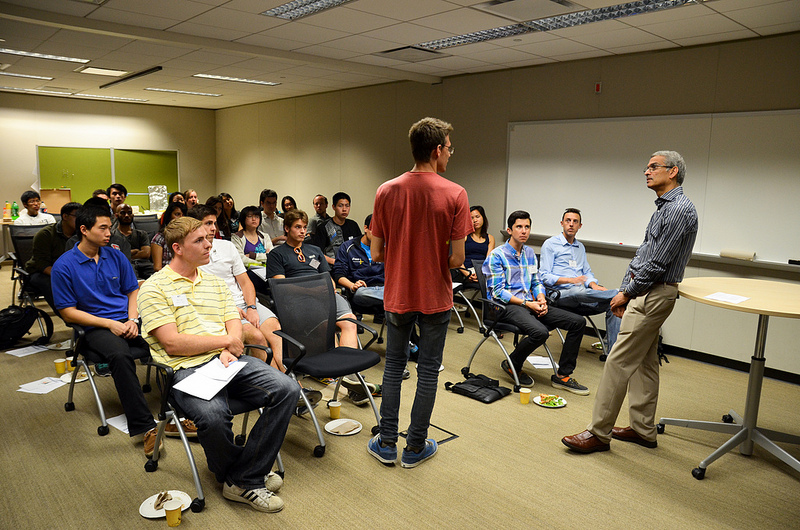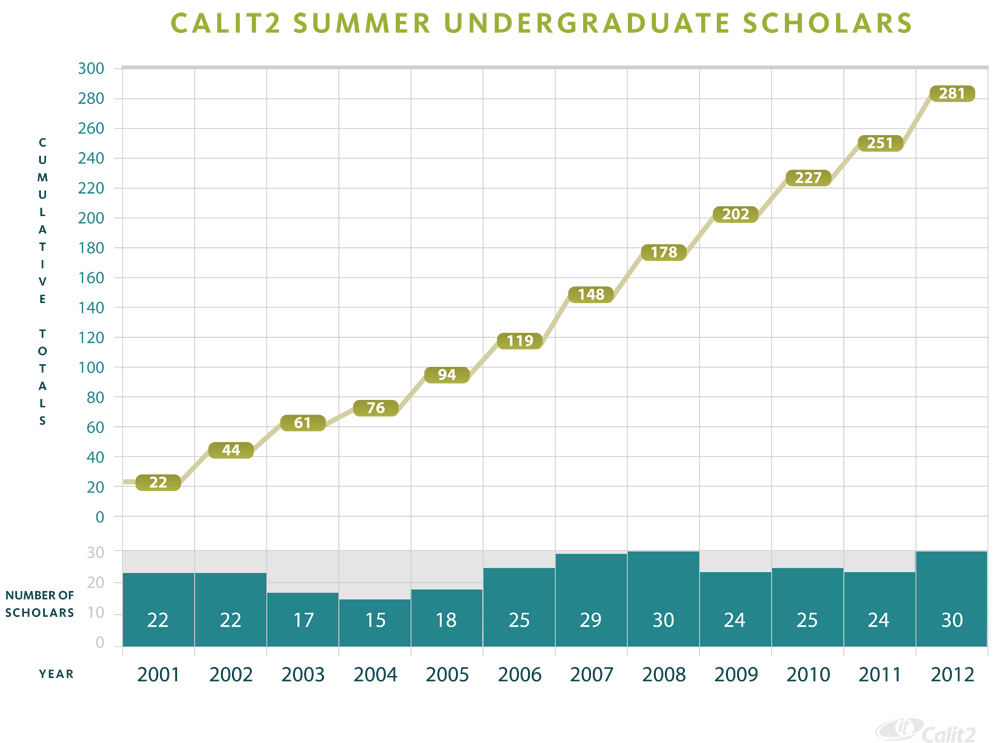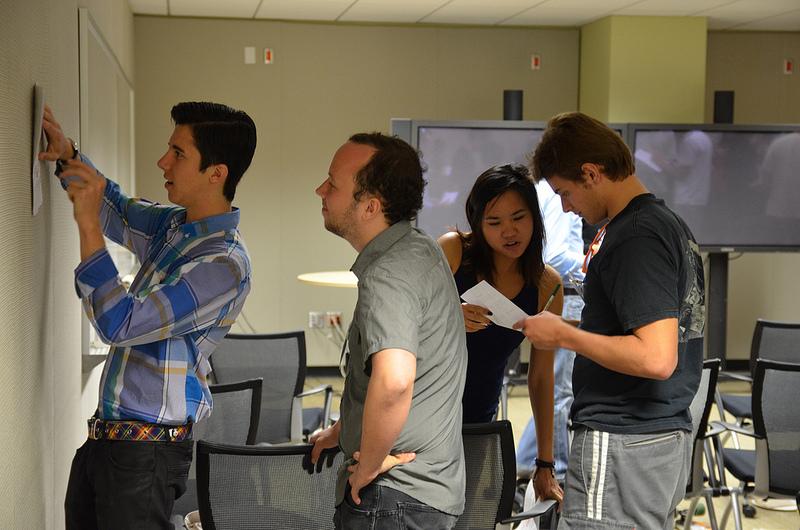News Release
Calit2 Class of 2012: Undergraduate Scholars Begin Their Summer of Research
 |
| Calit2 UCSD division director Ramesh Rao (far right) talks with visual arts sophomore Boris Boryakov during orientation for Calit2 Scholars. |
San Diego, CA, June 20, 2012 -- The UCSD division of Calit2 this week kicks off a summer of research opportunities for 30 undergraduates representing 17 academic majors. For the 12th summer in a row, Calit2 Summer Undergraduate Scholars are fanning out across campus to work full-time in the labs of Calit2-affiliated faculty members, doing research alongside graduate students, postdoctoral researchers and their advisors.
The 30 Calit2 Scholars were selected from among 77 applicants. This summer’s class matches the record number of 30 students selected in 2008. The total number of undergraduates going through the program since 2001 – when Calit2 was just six months old – has now topped 280 (see graphic).
Each scholar receives a $3,000 stipend for 10 weeks of work. Funding for the program comes from Calit2 industry partners, notably Qualcomm, Inc.
The range of projects undertaken by the Calit2 Scholars is impressive: from solar forecasting to virtual ethnoarchaeology, and from magnetization dynamics in nanoscale structures and devices to basal forebrain neuron firing patterns and their relationship with learning.
For the second year in a row, fewer than half of this year’s Calit2 Scholars – 40 percent – are engineering majors. “We have made a deliberate effort to encourage more students to apply from non-engineering disciplines,” said chemistry and biochemistry professor Barbara Sawrey, the faculty lead who oversees the Calit2 summer program. “This year 10 percent of our scholars are from the social sciences, and 13 percent from arts and humanities. We hope their presence will send a signal to other students in those fields that Calit2 values what they bring to the institute’s interdisciplinary mission.”
|
Seven of the 12 engineering majors hail from the Department of Bioengineering, the top major among 2012 scholars, followed by four majoring in pharmacological chemistry. The single most-represented department among this year’s undergraduates, however, is Chemistry and Biochemistry, with eight of the scholarships.
Majors represented among recipients included aerospace engineering, bioengineering, electrical engineering, mechanical and nanoengineering; biochemistry and cell biology, chemical physics, general chemistry, general biology, pharmacological chemistry, and physics; linguistics, cognitive science, anthropology, theatre, visual arts, and interdisciplinary computing and the arts (ICAM).
Many of the faculty advisors to this year’s crop of students are participating in the program for the first time. These include Hollis Cline (neuroscience), Michael Gilson (pharmacy), Mary Corr (medicine), Steven Wasserman and Gentry Patrick (biological sciences), Bruce Torbett (pathology), Amalia Arvaniti (linguistics), Jorge Hirsch (physics), among others.
Only a handful of the Calit2 Scholars are based in Atkinson Hall. These include sophomore Samuel Avery, an aerospace engineering major who is advised by Calit2 research scientist Albert Yu-Min Lin. Avery will investigate ways to reduce high-frequency multi-rotor helicopter frame vibration for aerial videography and photography. (The current version of the remote-controlled copter was developed by the UCSD-National Geographic Engineers for Exploration program managed by Lin.) Another Calit2 research scientist, Jurgen Schulze, has advised multiple Calit2 Scholars in the past decade; this summer he will help senior Nicholas Price, a Visual Arts/Media major, in a project titled “Lunar Colonization: Logistics and Ethics.”
|
Applicants must work in advance with faculty advisors to propose a 10-week project, to be carried out in the advisor’s lab or research group. For most of the Calit2 Scholars, it will be their first opportunity to undertake a full-time, hands-on research project – and to get a real taste of what a future in academic or industry research might be like. Traditionally, full-time research is reserved for graduate students, so the opportunity to do so earlier in their university careers is a major attraction to the Calit2 program.
Earlier Exposure to Research
One of the trends reflected in the demographics of the 2012 class is the shift to awarding fellowships to undergraduates earlier in their college experience. Until 2007, most of the Calit2 Scholars were seniors, and often graduating seniors, who left the university after completing their summer experience. This year, only four students are seniors (none of them graduating this year) and a similar number are freshmen. Fully half of all the Calit2 Scholars – 15 in all – are juniors, and seven are sophomores.
“This reflects the program’s desire to provide more opportunity for the scholars to continue their work in their advisors’ labs even after the summer is over,” said Ramesh Rao, Calit2’s division director at Â鶹´«Ã½. “It also means that next summer there will be a cohort of previous recipients who will still be on campus as undergrads, and many of them will advertise the program among their friends and hopefully mentor some of the younger scholars from next year’s program.”
|
Calit2's summer program enhances the research experience for the undergraduates with weekly activities (seminars and presentations, as well as social activities). The seminars are designed to help students plan for their future, whether for graduate school, industry or non-profits. Learning to explain their work in front of internal and external audiences with public presentations and research posters will take place over the course of the summer, culminating with a final poster session and select presentations at a Calit2 General Staff Meeting scheduled for September.
A complete list of the students (with photos), their majors, academic year, advisors and projects is available at .
2012 Calit2 Scholars and Research Topics
Jerad Acosta: Immersive Visualization: Combining Touch, Vision and Sound
Yahya Alvi: Silver Nanoprism Bowtie Assembly
Samuel Avery: Reduce High-Frequency Multi-Rotor Helicopter Frame Vibration for Aerial Videography and Photography
Boris Boryakov: Nano-Chemical Tattoos as Augmented Reality Markers: A Bridge Between Chemical and Conventional Computing
Tyler Capps: Solar Forecasting
Sara Choi: Preprocessing Stereo Videos for Surgery
James Darling: Virtual Ethnoarchaeology in South India: Exploring Meaning in Chola Bronze Icons
Ariel Dunn: Development of an In Vivo Reporter for Visualizing Movement from Cardiomyocytes During Early Stages of Embryonic Development
Sean Estelle: Design and implementation of the Phase 3 Drone Project
Jiahao Feng: Electric-Field Shielding/Screening in Superconductors
Dor Gabay: Magnetization Dynamics in Nanoscale Structures and Devices
Criccely Grijalva: Bilingual Mexican Spanish and Southern Californian Vowel Spaces
April Guan: Introduction and Characterization of Modified Green Fluorescent Protein (PDZ2-GFPu) in Neurons Through Viral Infection
Aditi Gupta: Basal Forebrain Neuron Firing Patterns and their Relationship with Learning
Norman Huang: Developing Stable, Single-Cell Traceable Co-Culture of Bacteria and Human Macrophage Cells to Observe T2 Activation and Offer a Comparative Analysis between Bacterial Stimuli and Artificial Stimulus Lipopolysaccharide (LPS)
Pek Ieong: Glycosylation Sites in Effect of Influenza Immunity
Devin Knece: HIV-1 Accessory Mutations Maintain Drug-Resistant Protease Stability
Michael Lam: Improving Health Science Through Computer Science: Detection of Behavior Locations Through Multiple Sensors
Adam Li: Focal Articular Cartilage Dfects and 3D Modeling
Alexander Lin: Scenedesmus for Biofuel Production: Whole Genome Sequencing and Assembly
Alexandra Martinez: Temporary Transfer Tattoo-Based Ion-Selective Electrodes for Non-Invasive Epidermal Monitoring of Electrolytes
Kyaw Naing: Alternatively Spliced Isoforms of Dif
Adrian Phillips: Interwoven Forms of Mixed Media
Nicholas Price: Lunar Colonization: Logistics and Ethics
Donald Ripatti: Searching for Cobalt Based Single-Molecule Magnets: Targeting Tetrahedral Co (2,6-Mes2C6H3TE)4 2-
Neeraj Sapra: Accuracy of Computational Methods for Predicting Molecular Binding Affinities and Application of Improbed Methods as a Basis for Design of a Novel Molecular Platform for Targeting Toxins to Tumors
Tyler Wishard: Control of nNeurogenesis by Fragile X Proteins
Joshua Yang: Assess the Role of Circulating Neutrophil DNA as a Clinical Marker of Sterile Inflammation and Assess Modulating the Level of Extracellular DNA as a Potential Therapeutic Strategy
Lu Yang: Designing Biodegradable Drug Delivery System for Age-Related Blindness Using Integrated Nanocapsules Using Programmable DNA Motors
Hao Zheng: mTOR-Regulated MicroRNA in Head and Neck Squamous Cell Carcinoma
Full details are on the Calit2 Scholars website at . Sessions for all Calit2 Scholars will take place at 11am each Tuesday and Thursday in Calit2 Room 4004, Atkinson Hall. The summer calendar is on the website at .
Related Links
Media Contacts
Doug Ramsey, 858-822-5825, dramsey@ucsd.edu
Program Contact: Amy Nguyen, a1nguyen@ucsd.edu
Media Contacts
Doug Ramsey
Jacobs School of Engineering
858-822-5825
dramsey@ucsd.edu
Ioana Patringenaru
Jacobs School of Engineering
858-822-0899
ipatrin@ucsd.edu


